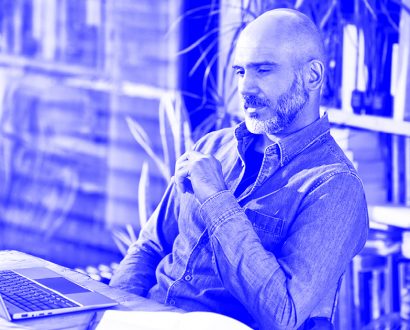New technologies, digital business models, and different attitudes and behaviours in society are fundamentally changing the rules of the economic game, reshaping the corporate playing field and altering the nature of the players themselves.
As humans it’s very hard for us to notice how we are thinking while we are doing our thinking. Such blissful ignorance and our tendency to indulge lifelong brain patterns, means we are constantly at risk of following historical paths of ‘tried and tested’ logic to disastrous consequences.
It’s time for a different style of thinking
In this increasingly volatile, complex and uncertain world, time itself has become a scarce and precious asset. Under time pressure, and with stakeholders impatient for results, we tend to go straight to the answer we know, and simply act without due consideration.
Many of the key questions of strategy and innovation that confront us defy such intellectual brute force. They represent ‘wicked problems’, with loosely defined parameters, multiple possible solutions and no clear vision at the outset of what success looks like. These problems demand the courage and determination necessary to adopt an adventurer’s mindset.
The adventurer makes the effort to understand the terrain and likely conditions they will encounter. Armed with map, compass (or smartphone), water and basic provisions, they set out prepared for any eventuality, determined to achieve a big picture goal such as crossing Antarctica unassisted. In truth, they have only a very rough idea of how they will accomplish their task, and concentrate much of their energy on identifying and building preparedness for the array of risks they will face.
Enter ‘design thinking’
Design thinking is an adventurous craft which has evolved from architecture and urban planning and been adopted by the world of business. The many ‘parents’ of design thinking include the Stanford Design Program dating back to 1958, which has evolved into the d.School, Carnegie Mellon’s School of Design, and the Massachusetts Institute of Technology. Its adaptation to the world of business was led by Stanford Professor David M. Kelley, who founded IDEO in 1991, a consulting firm which has become synonymous with design thinking.
Pioneers like Richard Buchanan, David M. Kelley, and Roger Martin have helped shift the concept of design in business from blueprint to discipline. Many leaders now recognise design thinking can be used to deeply understand industry trends and consumer behaviours, and create solutions and services that offer competitive advantage and drive profitable business growth. Design thinking is fundamentally a ‘discipline with attitude’ that helps create value, which can co-exist with traditional approaches we have inherited to manage value.
How does it work and what are the results?
According to Tim Brown, CEO and President of IDEO, “Design thinking is a human-centred approach to innovation that draws from the designer’s toolkit to integrate the needs of people, the possibilities of technology, and the requirements for business success.”
At Fujitsu we use a human-centric design thinking approach, with a Japanese twist. It helps clients to step out of the ‘complacent rationality’ we are normally so comfortable with. We work through 5 modes of thinking, which may follow in sequence, and then be repeated in any order as ideas are developed, rejected or refined.
Anchored in a deep understanding of the customer’s rational, emotional and physical needs and wants, we move through a creative process, combining logic and dialogue, and shifting gear from divergent to convergent thinking. As much as possible, we aim to have a wide range of ages, mindsets, cultural backgrounds and life experience in the room.
The design thinking approach comes with a huge range of tools and methods to support each stage or thinking mode. These include various idea cards to stimulate discussion, thinking frameworks like 2nd Road’s AcdB model, techniques such as ‘parallel worlds’ which help us dissociate from our own problem by exploring someone else’s (that is actually just like ours), and shifting perspective to imagine how someone else with a distinctly different mindset might approach the problem.
The wonderful American artist/designer Kelli Anderson captures the attitude of design thinking in her call for us to “reject the normal order of things, mess them up and re-arrange the pieces.” This is exactly the kind of constructive disobedience you will find at the heart of any design thinking style breakthrough:
- The Fosbury Flop high jump style was popularised and perfected by American athlete Dick Fosbury. His gold medal in the 1968 Summer Olympics brought this technique to the world’s attention. Who could have thought jumping backwards would mean going higher?
- Doug Dietz re-imagining General Electric’s Magnetic Resonance Imaging (MRI) machine as a pirate ship or space rocket, creating an exciting, immersive experience for young patients, instead of scaring them witless.
- Kelli Anderson and her friends published a fake edition of the New York Times in 2008, and distributed it to 80,000 people across major US cities, giving them a startling glimpse of ‘All the news they hoped to print’ six months into the future, instead of the ‘horror stories’ of today.
- The Wellington Fire Service spread their fire safety message online via classified ads in New Zealand, featuring reasonably priced rental properties with just one problem–they have been destroyed by fire.
In the business world, we have been helping clients re-imagine the customer experience in transport, to redesign the way maintenance work is conducted for water infrastructure and look at how governments can enable ‘trusted traveller’ and ‘trusted trader’ models to streamline the entire customs and immigration framework.
Can we all do it?
Thanks to neuroplasticity, with the opportunity and right motivation, yes we can. While it can be very difficult for us to ‘unlearn’ things or to quit bad habits, our brain structure and cognitive skills can be altered.
Design thinking is just the calisthenics we need for our minds. Its tools and methods can be employed in individual conversations to shift perspectives, in workshops to create breakthrough ideas, as a strategic discipline to drive innovation, and to enable ongoing organisational renewal.








